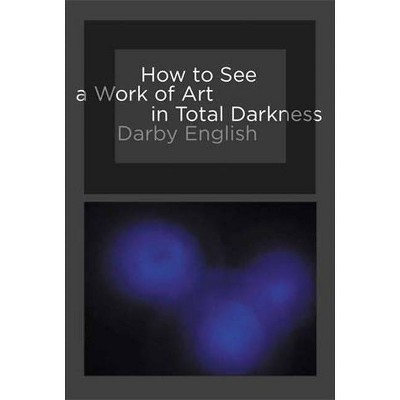How to See a Work of Art in Total Darkness - (Mit Press) by Darby English (Paperback)

Similar Products
Products of same category from the store
AllProduct info
<p/><br></br><p><b> About the Book </b></p></br></br>Going beyond the 'blackness' of black art to examine the integrative and interdisciplinary practices of Kara Walker, Fred Wilson, Isaac Julien, Glenn Ligon, and William Pope.L--five contemporary black artists in whose work race plays anything but a defining role.<p/><br></br><p><b> Book Synopsis </b></p></br></br><b>Going beyond the 'blackness' of black art to examine the integrative and interdisciplinary practices of Kara Walker, Fred Wilson, Isaac Julien, Glenn Ligon, and William Pope.L--five contemporary black artists in whose work race plays anything but a defining role.</b><p>Work by black artists today is almost uniformly understood in terms of its blackness, with audiences often expecting or requiring it to represent the race. In <i>How to See a Work of Art in Total Darkness</i>, Darby English shows how severely such expectations limit the scope of our knowledge about this work and how different it looks when approached on its own terms. Refusing to grant racial blackness--his metaphorical total darkness--primacy over his subjects' other concerns and contexts, he brings to light problems and possibilities that arise when questions of artistic priority and freedom come into contact, or even conflict, with those of cultural obligation. English examines the integrative and interdisciplinary strategies of five contemporary artists--Kara Walker, Fred Wilson, Isaac Julien, Glenn Ligon, and William Pope.L--stressing the ways in which this work at once reflects and alters our view of its informing context: the advent of postmodernity in late twentieth-century American art and culture.</p><p>The necessity for black art comes both from antiblack racism and resistances to it, from both segregation and efforts to imagine an autonomous domain of black culture. Yet to judge by the work of many contemporary practitioners, English writes, black art is increasingly less able--and black artists less willing--to maintain its standing as a realm apart. Through close examinations of Walker's controversial silhouettes' insubordinate reply to pictorial tradition, Wilson's and Julien's distinct approaches to institutional critique, Ligon's text paintings' struggle with modernisms, and Pope.L's vexing performance interventions, English grounds his contention that to understand this work is to displace race from its central location in our interpretation and to grant right of way to the work's historical, cultural, and aesthetic specificity.</p><p/><br></br><p><b> Review Quotes </b></p></br></br><br>English's discursive and dialectical way of comprehending the practices of black artists emancipates both 'black art' and 'black artists' and provides a necessary road for creative ways to 'do' African American art history.--<b>Steven Nelson </b>, <i>Art Bulletin</i>--<br><p>Equally thorough and successful in his presentation of new readings to familiar works of art, English reminds the reader with each carefully considered example that 'to take this art seriously is to traffic in the unfamiliar.'</p>--<b>Jennifer Jordan</b>, <i>Camerawork</i>--<br><p>...<i>How to See</i> is a timely and relevant book, opening a debate that is long overdue.</p>--<i>Art Review</i>--<br>
Price History
Price Archive shows prices from various stores, lets you see history and find the cheapest. There is no actual sale on the website. For all support, inquiry and suggestion messagescommunication@pricearchive.us



















